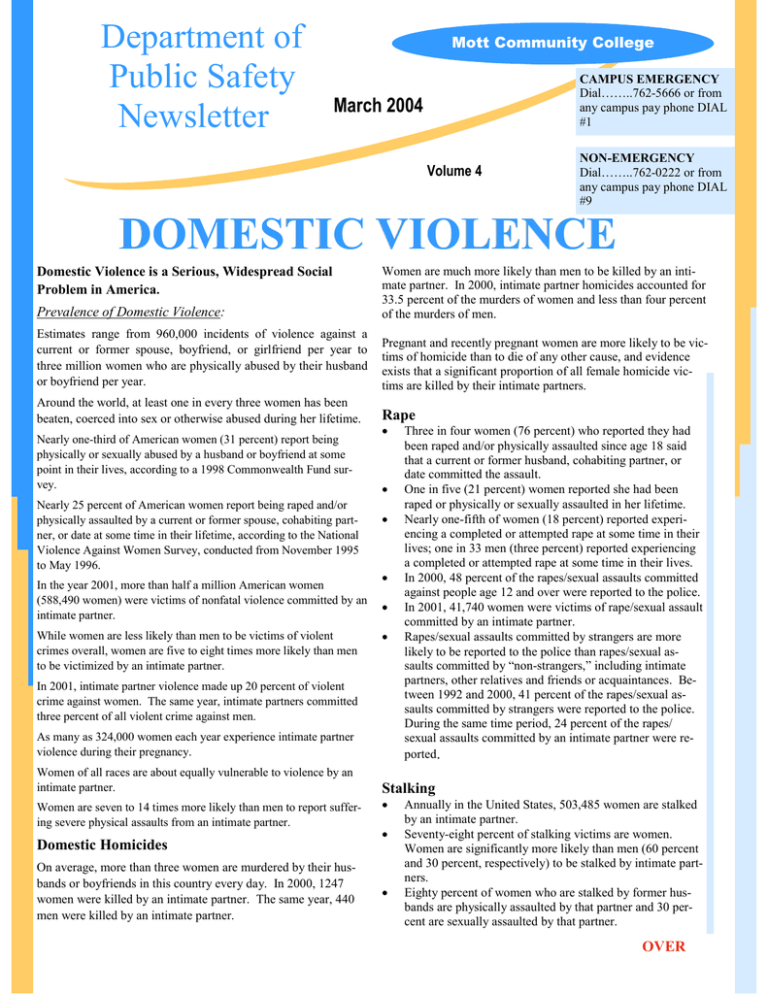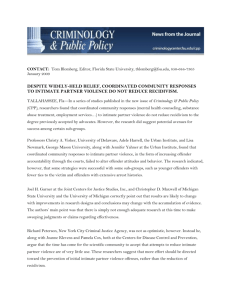
Department of
Public Safety
Newsletter
Mott Community College
CAMPUS EMERGENCY
Dial……..762-5666 or from
any campus pay phone DIAL
#1
March 2004
Volume 4
NON-EMERGENCY
Dial……..762-0222 or from
any campus pay phone DIAL
#9
DOMESTIC VIOLENCE
Prevalence of Domestic Violence:
Women are much more likely than men to be killed by an intimate partner. In 2000, intimate partner homicides accounted for
33.5 percent of the murders of women and less than four percent
of the murders of men.
Estimates range from 960,000 incidents of violence against a
current or former spouse, boyfriend, or girlfriend per year to
three million women who are physically abused by their husband
or boyfriend per year.
Pregnant and recently pregnant women are more likely to be victims of homicide than to die of any other cause, and evidence
exists that a significant proportion of all female homicide victims are killed by their intimate partners.
Around the world, at least one in every three women has been
beaten, coerced into sex or otherwise abused during her lifetime.
Rape
Nearly one-third of American women (31 percent) report being
physically or sexually abused by a husband or boyfriend at some
point in their lives, according to a 1998 Commonwealth Fund survey.
•
Domestic Violence is a Serious, Widespread Social
Problem in America.
Nearly 25 percent of American women report being raped and/or
physically assaulted by a current or former spouse, cohabiting partner, or date at some time in their lifetime, according to the National
Violence Against Women Survey, conducted from November 1995
to May 1996.
In the year 2001, more than half a million American women
(588,490 women) were victims of nonfatal violence committed by an
intimate partner.
While women are less likely than men to be victims of violent
crimes overall, women are five to eight times more likely than men
to be victimized by an intimate partner.
•
•
•
•
•
In 2001, intimate partner violence made up 20 percent of violent
crime against women. The same year, intimate partners committed
three percent of all violent crime against men.
As many as 324,000 women each year experience intimate partner
violence during their pregnancy.
Women of all races are about equally vulnerable to violence by an
intimate partner.
Women are seven to 14 times more likely than men to report suffering severe physical assaults from an intimate partner.
Domestic Homicides
On average, more than three women are murdered by their husbands or boyfriends in this country every day. In 2000, 1247
women were killed by an intimate partner. The same year, 440
men were killed by an intimate partner.
Three in four women (76 percent) who reported they had
been raped and/or physically assaulted since age 18 said
that a current or former husband, cohabiting partner, or
date committed the assault.
One in five (21 percent) women reported she had been
raped or physically or sexually assaulted in her lifetime.
Nearly one-fifth of women (18 percent) reported experiencing a completed or attempted rape at some time in their
lives; one in 33 men (three percent) reported experiencing
a completed or attempted rape at some time in their lives.
In 2000, 48 percent of the rapes/sexual assaults committed
against people age 12 and over were reported to the police.
In 2001, 41,740 women were victims of rape/sexual assault
committed by an intimate partner.
Rapes/sexual assaults committed by strangers are more
likely to be reported to the police than rapes/sexual assaults committed by “non-strangers,” including intimate
partners, other relatives and friends or acquaintances. Between 1992 and 2000, 41 percent of the rapes/sexual assaults committed by strangers were reported to the police.
During the same time period, 24 percent of the rapes/
sexual assaults committed by an intimate partner were reported.
Stalking
•
•
•
Annually in the United States, 503,485 women are stalked
by an intimate partner.
Seventy-eight percent of stalking victims are women.
Women are significantly more likely than men (60 percent
and 30 percent, respectively) to be stalked by intimate partners.
Eighty percent of women who are stalked by former husbands are physically assaulted by that partner and 30 percent are sexually assaulted by that partner.
OVER
Domestic Violence Laws in Michigan
I. PERSONAL PROTECTON ORDERS
Personal protection orders (formerly restraining orders) (pursuant to MCLA 600.2950) are civil orders of the circuit court designed to
protect domestic violence victims. The victim must demonstrate to the circuit court that there is reasonable cause to believe that the person they are seeking the order against may commit one or more of the acts. An attorney is needed to present this complaint to the circuit
court. The request must state specific incidents of assaults/and/or threats, and may describe injuries sustained and names of witnesses.
Personal protection orders (pursuant to the MCLA 600.2950) are for domestic violence victims only. A relationship must exist between
the victim or the perpetrator. They must be: married, formerly married, residing together, formerly residing together, have a child in
common 7/1/94, or have a dating or formerly dating relationship 4/1/95.
You can get the PPO forms and assistance in completing the forms at:
•
Genesee County Clerk’s Office
900 S. Saginaw St.
•
YWCA, Legal Advocacy
310 E. Third St. 8th Floor Flint, MI 48502 Telephone: (810) 238-7621
•
Legal Services of Eastern Michigan
547 S. Saginaw St.
Flint, MI 48502 Telephone: (810) 234-2621 or (800) 339-9513
•
Victim Advocacy Program
630 S. Saginaw St.
Flint, MI 48502 Telephone: (810)766-8994
Flint, MI 48502 Telephone: (810) 257-3220 or 257-3610
II. ASSAULT AND BATTERY [MCLA 750.81]
Michigan Law defines a criminal assault and battery as an attempt or offer to do bodily injury with a present intention and ability to do
so. Assault is an attempt or threat, with unlawful force, to inflict bodily injury upon another, accompanied by the apparent present ability
to carry out the intent if not deterred by another. A threat coupled with present ability may be considered an assault. Battery is the actual
physical harm.
III. AGGRAVATED ASSAULT/ASSAULT AND INFLICTION OF SERIOUS INJURY [MCLA 750.81a]
Any person who shall assault another without any weapon and inflict serious or aggravated injury upon the person of another without intending to commit the crime of murder and without intending to inflict great bodily harm less than the crime of murder, shall be guilty of
a high misdemeanor, punishable by imprisonment in the county jail or the state prison for a period of not more than one year or a fine of
$500 or both.
IV. ASSAULT WITH INTENT TO COMMIT MURDER.FELONY [MCLA 750.83]
Any person who shall assault another with intent to commit the crime of murder, shall be guilty of a felony, punishable by
imprisonment in the state prison for life or any number of years.
V. CRIMINAL SEXUAL CONDUCT [MCLA 750.520]
There are four degrees of criminal sexual conduct (usually known as rape). First, second, and third degrees are felonies.
Fourth degree is a misdemeanor.
VI. STALKING LAWS
As of January 1, 1993, stalking is a crime in Michigan. Under the new laws created, a victim may press charges against a
stalker, obtain a restraining order with provisions for immediate arrest and criminal contempt penalties, and sue for actual
and exemplary damages caused by the stalker. These new laws allow punishment for what was previously legal, though despicable, behavior. Police, prosecutors and judges have been given the tools necessary to afford victims greater protection
from assailants. However, since the laws are so new, we have little information on how they will be applied in practice. If
you are being stalked by your assailant, call the police. We also strongly encourage you to contact an advocate at the domestic violence project for further assistance.
Stalking is defined as a willful course of conduct involving repeated or continuing harassment of another individual that
would cause a reasonable person to feel terrorized, frightened, intimidated, threatened, harassed or molested, and that actually causes the victim to feel terrorized, frightened, intimidated, threatened, harassed, or molested. Behavior such as following you, showing up at your home or at work, confronting you in public or in private, making unwanted calls or sending unwanted letters, or leaving objects or “presents” for you at home, work, on/in your car or other property can be used as evidence of stalking. Stalking is a misdemeanor, punishable by imprisonment of up to one year and/or a fine of up to $1,000.
In addition
to incarceration and fines, an individual found guilty of stalking may also be put on probation for
up to five years.
2
Department
of
The terms of probation may include an anti-stalking order, a no contact order, and/or mandatory counseling for
the assailant,
Public
Safety
at his/her own expense.



